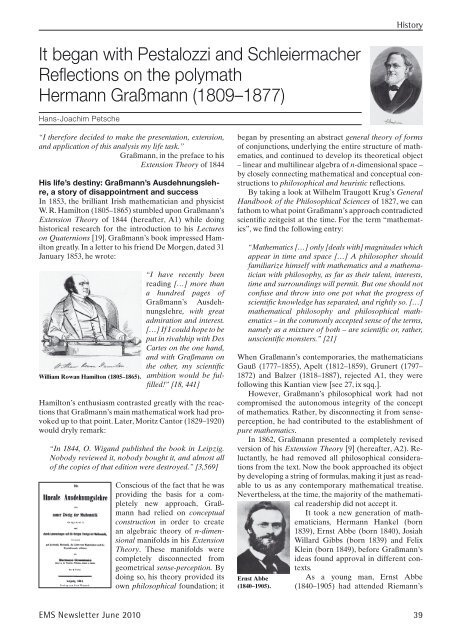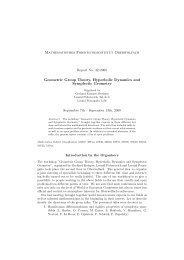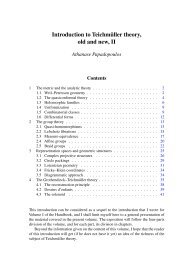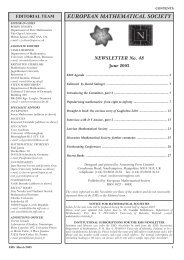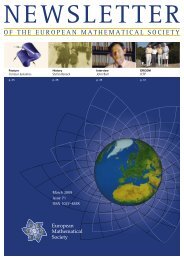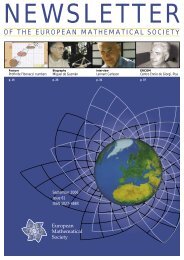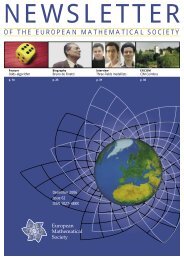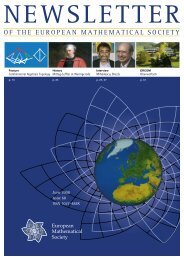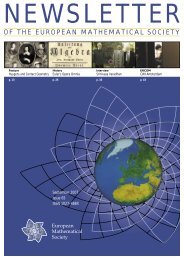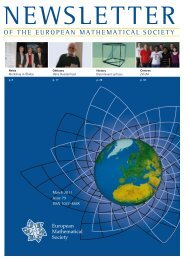EMS Newsletter June 2010 - European Mathematical Society ...
EMS Newsletter June 2010 - European Mathematical Society ...
EMS Newsletter June 2010 - European Mathematical Society ...
You also want an ePaper? Increase the reach of your titles
YUMPU automatically turns print PDFs into web optimized ePapers that Google loves.
It began with Pestalozzi and Schleiermacher<br />
Reflections on the polymath<br />
Hermann Graßmann (1809–1877)<br />
Hans-Joachim Petsche<br />
“I therefore decided to make the presentation, extension,<br />
and application of this analysis my life task.”<br />
Graßmann, in the preface to his<br />
Extension Theory of 1844<br />
His life’s destiny: Graßmann’s Ausdehnungslehre,<br />
a story of disappointment and success<br />
In 1853, the brilliant Irish mathematician and physicist<br />
W. R. Hamilton (1805–1865) stumbled upon Graßmann’s<br />
Extension Theory of 1844 (hereafter, A1) while doing<br />
historical research for the introduction to his Lectures<br />
on Quaternions [19]. Graßmann’s book impressed Hamilton<br />
greatly. In a letter to his friend De Morgen, dated 31<br />
January 1853, he wrote:<br />
William Rowan Hamilton (1805–1865).<br />
“I have recently been<br />
reading […] more than<br />
a hundred pages of<br />
Graßmann’s Ausdehnungslehre,<br />
with great<br />
admiration and interest.<br />
[…] If I could hope to be<br />
put in rivalship with Des<br />
Cartes on the one hand,<br />
and with Graßmann on<br />
the other, my scientific<br />
ambition would be fulfilled!”<br />
[18, 441]<br />
Hamilton’s enthusiasm contrasted greatly with the reactions<br />
that Graßmann’s main mathematical work had provoked<br />
up to that point. Later, Moritz Cantor (1829–1920)<br />
would dryly remark:<br />
“In 1844, O. Wigand published the book in Leipzig.<br />
Nobody reviewed it, nobody bought it, and almost all<br />
of the copies of that edition were destroyed.” [3,569]<br />
Conscious of the fact that he was<br />
providing the basis for a completely<br />
new approach, Graßmann<br />
had relied on conceptual<br />
construction in order to create<br />
an algebraic theory of n-dimensional<br />
manifolds in his Extension<br />
Theory. These manifolds were<br />
completely disconnected from<br />
geometrical sense-perception. By<br />
doing so, his theory provided its<br />
own philosophical foundation; it<br />
History<br />
began by presenting an abstract general theory of forms<br />
of conjunctions, underlying the entire structure of mathematics,<br />
and continued to develop its theoretical object<br />
– linear and multilinear algebra of n-dimensional space –<br />
by closely connecting mathematical and conceptual constructions<br />
to philosophical and heuristic reflections.<br />
By taking a look at Wilhelm Traugott Krug’s General<br />
Handbook of the Philosophical Sciences of 1827, we can<br />
fathom to what point Graßmann’s approach contradicted<br />
scientific zeitgeist at the time. For the term “mathematics”,<br />
we find the following entry:<br />
“Mathematics […] only [deals with] magnitudes which<br />
appear in time and space […] A philosopher should<br />
familiarize himself with mathematics and a mathematician<br />
with philosophy, as far as their talent, interests,<br />
time and surroundings will permit. But one should not<br />
confuse and throw into one pot what the progress of<br />
scientific knowledge has separated, and rightly so. […]<br />
mathematical philosophy and philosophical mathematics<br />
– in the commonly accepted sense of the terms,<br />
namely as a mixture of both – are scientific or, rather,<br />
unscientific monsters.” [21]<br />
When Graßmann’s contemporaries, the mathematicians<br />
Gauß (1777–1855), Apelt (1812–1859), Grunert (1797–<br />
1872) and Balzer (1818–1887), rejected A1, they were<br />
following this Kantian view [see 27, ix sqq.].<br />
However, Graßmann’s philosophical work had not<br />
compromised the autonomous integrity of the concept<br />
of mathematics. Rather, by disconnecting it from senseperception,<br />
he had contributed to the establishment of<br />
pure mathematics.<br />
In 1862, Graßmann presented a completely revised<br />
version of his Extension Theory [9] (hereafter, A2). Reluctantly,<br />
he had removed all philosophical considerations<br />
from the text. Now the book approached its object<br />
by developing a string of formulas, making it just as readable<br />
to us as any contemporary mathematical treatise.<br />
Nevertheless, at the time, the majority of the mathematical<br />
readership did not accept it.<br />
It took a new generation of mathematicians,<br />
Hermann Hankel (born<br />
1839), Ernst Abbe (born 1840), Josiah<br />
Willard Gibbs (born 1839) and Felix<br />
Klein (born 1849), before Graßmann’s<br />
ideas found approval in different contexts.<br />
Ernst Abbe<br />
(1840–1905).<br />
As a young man, Ernst Abbe<br />
(1840–1905) had attended Riemann’s<br />
<strong>EMS</strong> <strong>Newsletter</strong> <strong>June</strong> <strong>2010</strong> 39


